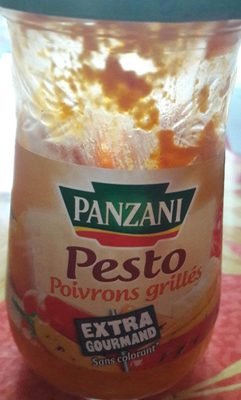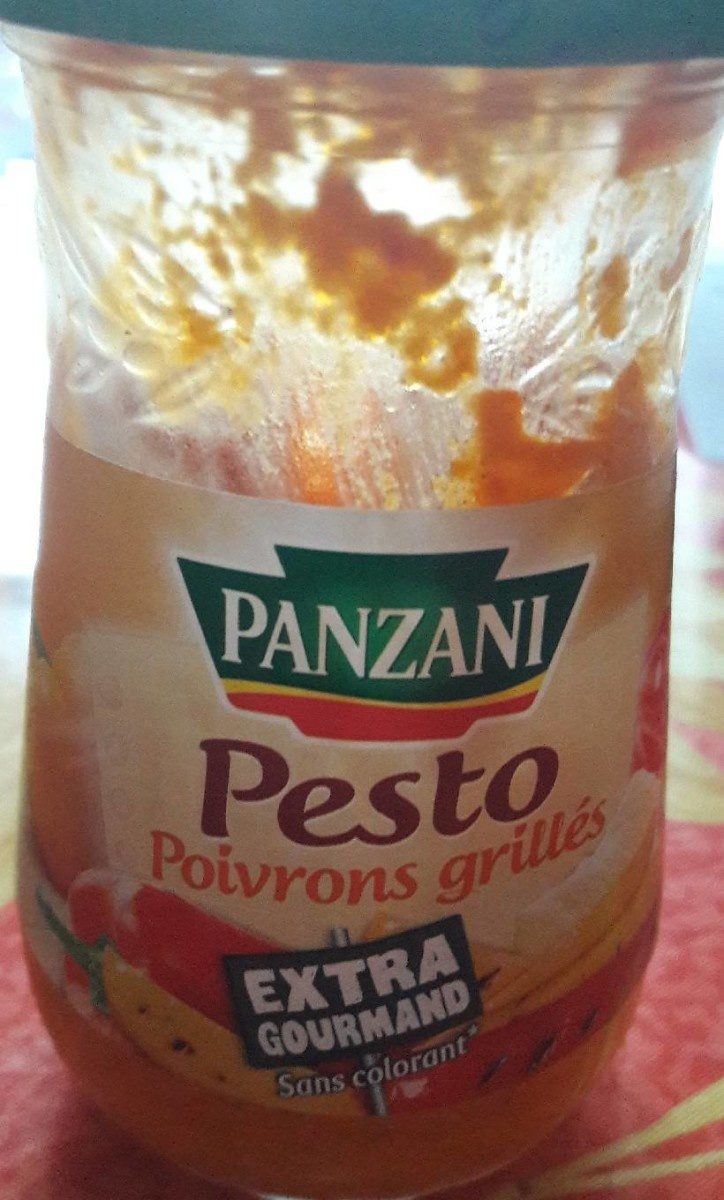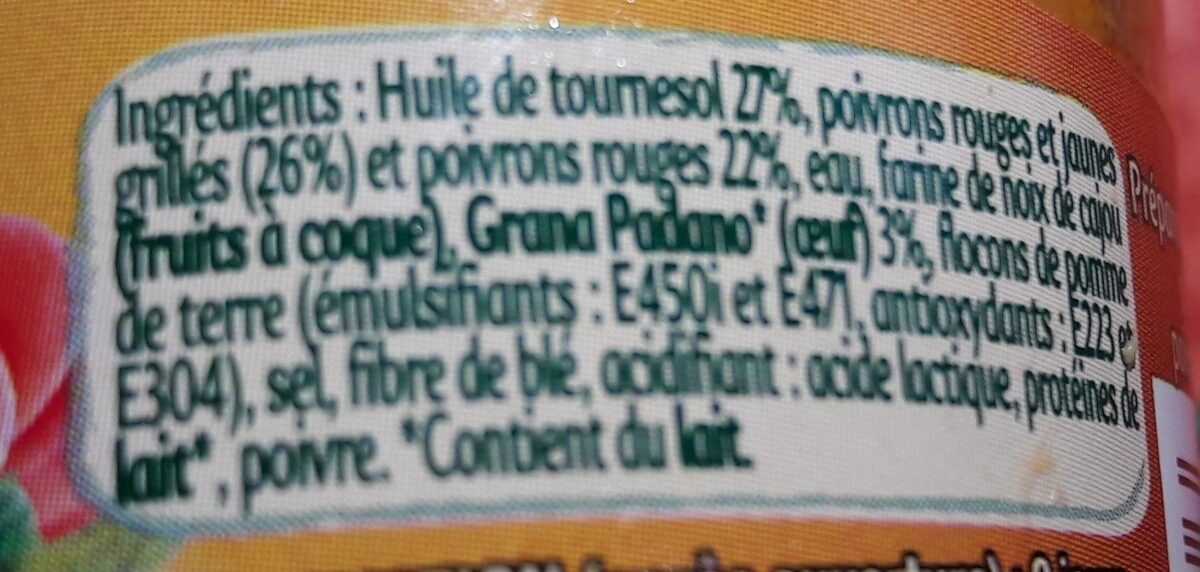Help us make food transparency the norm!
As a non-profit organization, we depend on your donations to continue informing consumers around the world about what they eat.
The food revolution starts with you!
Sauce pesto poivrons grillés - Panzani - 190 g
Sauce pesto poivrons grillés - Panzani - 190 g
This product page is not complete. You can help to complete it by editing it and adding more data from the photos we have, or by taking more photos using the app for Android or iPhone/iPad. Thank you!
×
Barcode: 3038354179506 (EAN / EAN-13)
Common name: Préparations à base d'huile et de poivrons grillés
Quantity: 190 g
Packaging: Jar
Brands: Panzani
Categories: Condiments, Sauces, Pestos, Groceries
Labels, certifications, awards: No colorings
Manufacturing or processing places: Italie
Stores: Auchan
Countries where sold: France, Switzerland
Matching with your preferences
Health
Ingredients
-
20 ingredients
: Huile de tournesol 27%, poivrons rouges et jaunes grillés (26%), poivrons rouges 22%, eau, farine de noix de cajou (fruits à coque), Grana Padano (œuf) 3%, flocons de pomme de terre (émulsifiants : E450i et E471, antioxydants : E223 et E304), sel, fibre de blé, acidifiant : acide lactique, protéines de lait, poivre.Allergens: Eggs, Gluten, Milk, Nuts
Food processing
-
Ultra processed foods
Elements that indicate the product is in the 4 - Ultra processed food and drink products group:
- Additive: E450 - Diphosphates
- Additive: E471 - Mono- and diglycerides of fatty acids
- Ingredient: Emulsifier
- Ingredient: Milk proteins
Food products are classified into 4 groups according to their degree of processing:
- Unprocessed or minimally processed foods
- Processed culinary ingredients
- Processed foods
- Ultra processed foods
The determination of the group is based on the category of the product and on the ingredients it contains.
Additives
-
E223 - Sodium metabisulphite
Sodium metabisulfite: Sodium metabisulfite or sodium pyrosulfite -IUPAC spelling; Br. E. sodium metabisulphite or sodium pyrosulphite- is an inorganic compound of chemical formula Na2S2O5. The substance is sometimes referred to as disodium metabisulfite. It is used as a disinfectant, antioxidant, and preservative agent.Source: Wikipedia
-
E270 - Lactic acid
Lactic acid: Lactic acid is an organic compound with the formula CH3CH-OH-COOH. In its solid state, it is white and water-soluble. In its liquid state, it is colorless. It is produced both naturally and synthetically. With a hydroxyl group adjacent to the carboxyl group, lactic acid is classified as an alpha-hydroxy acid -AHA-. In the form of its conjugate base called lactate, it plays a role in several biochemical processes. In solution, it can ionize a proton from the carboxyl group, producing the lactate ion CH3CH-OH-CO−2. Compared to acetic acid, its pKa is 1 unit less, meaning lactic acid deprotonates ten times more easily than acetic acid does. This higher acidity is the consequence of the intramolecular hydrogen bonding between the α-hydroxyl and the carboxylate group. Lactic acid is chiral, consisting of two optical isomers. One is known as L--+--lactic acid or -S--lactic acid and the other, its mirror image, is D--−--lactic acid or -R--lactic acid. A mixture of the two in equal amounts is called DL-lactic acid, or racemic lactic acid. Lactic acid is hygroscopic. DL-lactic acid is miscible with water and with ethanol above its melting point which is around 17 or 18 °C. D-lactic acid and L-lactic acid have a higher melting point. In animals, L-lactate is constantly produced from pyruvate via the enzyme lactate dehydrogenase -LDH- in a process of fermentation during normal metabolism and exercise. It does not increase in concentration until the rate of lactate production exceeds the rate of lactate removal, which is governed by a number of factors, including monocarboxylate transporters, concentration and isoform of LDH, and oxidative capacity of tissues. The concentration of blood lactate is usually 1–2 mM at rest, but can rise to over 20 mM during intense exertion and as high as 25 mM afterward. In addition to other biological roles, L-lactic acid is the primary endogenous agonist of hydroxycarboxylic acid receptor 1 -HCA1-, which is a Gi/o-coupled G protein-coupled receptor -GPCR-.In industry, lactic acid fermentation is performed by lactic acid bacteria, which convert simple carbohydrates such as glucose, sucrose, or galactose to lactic acid. These bacteria can also grow in the mouth; the acid they produce is responsible for the tooth decay known as caries. In medicine, lactate is one of the main components of lactated Ringer's solution and Hartmann's solution. These intravenous fluids consist of sodium and potassium cations along with lactate and chloride anions in solution with distilled water, generally in concentrations isotonic with human blood. It is most commonly used for fluid resuscitation after blood loss due to trauma, surgery, or burns.Source: Wikipedia
-
E304 - Fatty acid esters of ascorbic acid
Ascorbyl palmitate: Ascorbyl palmitate is an ester formed from ascorbic acid and palmitic acid creating a fat-soluble form of vitamin C. In addition to its use as a source of vitamin C, it is also used as an antioxidant food additive -E number E304-. It is approved for use as a food additive in the EU, the U.S., Canada, Australia, and New Zealand.Ascorbyl palmitate is known to be broken down -through the digestive process- into ascorbic acid and palmitic acid -a saturated fatty acid- before being absorbed into the bloodstream. Ascorbyl palmitate is also marketed as "vitamin C ester".Source: Wikipedia
-
E450 - Diphosphates
Diphosphates (E450) are food additives often utilized to modify the texture of products, acting as leavening agents in baking and preventing the coagulation of canned food.
These salts can stabilize whipped cream and are also found in powdered products to maintain their flow properties. They are commonly present in baked goods, processed meats, and soft drinks.
Derived from phosphoric acid, they're part of our daily phosphate intake, which often surpasses recommended levels due to the prevalence of phosphates in processed foods and drinks.
Excessive phosphate consumption is linked to health issues, such as impaired kidney function and weakened bone health. Though diphosphates are generally regarded as safe when consumed within established acceptable daily intakes, it's imperative to monitor overall phosphate consumption to maintain optimal health.
-
E471 - Mono- and diglycerides of fatty acids
Mono- and diglycerides of fatty acids (E471), are food additives commonly used as emulsifiers in various processed foods.
These compounds consist of glycerol molecules linked to one or two fatty acid chains, which help stabilize and blend water and oil-based ingredients. E471 enhances the texture and shelf life of products like margarine, baked goods, and ice cream, ensuring a smooth and consistent texture.
It is generally considered safe for consumption within established regulatory limits.
Ingredients analysis
-
May contain palm oil
Ingredients that may contain palm oil: E471, E304
-
Non-vegan
Non-vegan ingredients: Grana Padano, Milk proteins
-
Maybe vegetarian
Ingredients that may not be vegetarian: Grana Padano, E471, E304
-
Details of the analysis of the ingredients
: Huile de tournesol 27%, poivrons rouges, poivrons jaunes 26%, poivrons rouges 22%, eau, noix de cajou, Grana Padano 3%, flocons de pomme de terre (émulsifiants (e450i), e471, antioxydants (e223), e304), sel, fibre de blé, acidifiant (acide lactique), protéines de lait, poivre- Huile de tournesol -> en:sunflower-oil - vegan: yes - vegetarian: yes - from_palm_oil: no - ciqual_food_code: 17440 - percent: 27
- poivrons rouges -> en:red-bell-pepper - vegan: yes - vegetarian: yes - ciqual_food_code: 20087
- poivrons jaunes -> en:yellow-bell-pepper - vegan: yes - vegetarian: yes - ciqual_food_code: 20168 - percent: 26
- poivrons rouges -> en:red-bell-pepper - vegan: yes - vegetarian: yes - ciqual_food_code: 20087 - percent: 22
- eau -> en:water - vegan: yes - vegetarian: yes - ciqual_food_code: 18066
- noix de cajou -> en:cashew-nuts - vegan: yes - vegetarian: yes - ciqual_proxy_food_code: 15055
- Grana Padano -> en:grana-padano - vegan: no - vegetarian: maybe - ciqual_food_code: 12123 - percent: 3
- flocons de pomme de terre -> en:potato-flakes - vegan: yes - vegetarian: yes - ciqual_food_code: 4003
- émulsifiants -> en:emulsifier
- e450i -> en:e450i - vegan: yes - vegetarian: yes
- e471 -> en:e471 - vegan: maybe - vegetarian: maybe - from_palm_oil: maybe
- antioxydants -> en:antioxidant
- e223 -> en:e223 - vegan: yes - vegetarian: yes
- e304 -> en:e304 - vegan: maybe - vegetarian: maybe - from_palm_oil: maybe
- émulsifiants -> en:emulsifier
- sel -> en:salt - vegan: yes - vegetarian: yes - ciqual_food_code: 11058
- fibre de blé -> en:wheat-fiber - vegan: yes - vegetarian: yes
- acidifiant -> en:acid
- acide lactique -> en:e270 - vegan: yes - vegetarian: yes
- protéines de lait -> en:milk-proteins - vegan: no - vegetarian: yes
- poivre -> en:pepper - vegan: yes - vegetarian: yes
Nutrition
-
Poor nutritional quality
⚠ ️Warning: the amount of fiber is not specified, their possible positive contribution to the grade could not be taken into account.⚠ ️Warning: the amount of fruits, vegetables and nuts is not specified on the label, it was estimated from the list of ingredients: 84This product is not considered a beverage for the calculation of the Nutri-Score.
Positive points: 7
- Proteins: 2 / 5 (value: 3.9, rounded value: 3.9)
- Fiber: 0 / 5 (value: 0, rounded value: 0)
- Fruits, vegetables, nuts, and colza/walnut/olive oils: 5 / 5 (value: 84.5, rounded value: 84.5)
Negative points: 18
- Energy: 4 / 10 (value: 1345, rounded value: 1345)
- Sugars: 0 / 10 (value: 3.2, rounded value: 3.2)
- Saturated fat: 4 / 10 (value: 4.7, rounded value: 4.7)
- Sodium: 10 / 10 (value: 1000, rounded value: 1000)
The points for proteins are counted because the points for the fruits, vegetables, nuts and colza/walnut/olive oils are at the maximum.
Nutritional score: (18 - 7)
Nutri-Score:
-
Nutrient levels
-
Fat in high quantity (30%)
What you need to know- A high consumption of fat, especially saturated fats, can raise cholesterol, which increases the risk of heart diseases.
Recommendation: Limit the consumption of fat and saturated fat- Choose products with lower fat and saturated fat content.
-
Saturated fat in moderate quantity (4.7%)
What you need to know- A high consumption of fat, especially saturated fats, can raise cholesterol, which increases the risk of heart diseases.
Recommendation: Limit the consumption of fat and saturated fat- Choose products with lower fat and saturated fat content.
-
Sugars in low quantity (3.2%)
What you need to know- A high consumption of sugar can cause weight gain and tooth decay. It also augments the risk of type 2 diabetes and cardio-vascular diseases.
Recommendation: Limit the consumption of sugar and sugary drinks- Sugary drinks (such as sodas, fruit beverages, and fruit juices and nectars) should be limited as much as possible (no more than 1 glass a day).
- Choose products with lower sugar content and reduce the consumption of products with added sugars.
-
Salt in high quantity (2.5%)
What you need to know- A high consumption of salt (or sodium) can cause raised blood pressure, which can increase the risk of heart disease and stroke.
- Many people who have high blood pressure do not know it, as there are often no symptoms.
- Most people consume too much salt (on average 9 to 12 grams per day), around twice the recommended maximum level of intake.
Recommendation: Limit the consumption of salt and salted food- Reduce the quantity of salt used when cooking, and don't salt again at the table.
- Limit the consumption of salty snacks and choose products with lower salt content.
-
-
Nutrition facts
Nutrition facts As sold
for 100 g / 100 mlCompared to: Pestos Energy 1,345 kj
(326 kcal)-25% Fat 30 g -28% Saturated fat 4.7 g -23% Carbohydrates 8.2 g +24% Sugars 3.2 g +4% Fiber ? Proteins 3.9 g -16% Salt 2.5 g +14% Fruits‚ vegetables‚ nuts and rapeseed‚ walnut and olive oils (estimate from ingredients list analysis) 84.5 %
Environment
-
Eco-Score C - Moderate environmental impact
⚠ ️Select a country in order to include the full impact of transportation.The Eco-Score is an experimental score that summarizes the environmental impacts of food products.→ The Eco-Score was initially developped for France and it is being extended to other European countries. The Eco-Score formula is subject to change as it is regularly improved to make it more precise and better suited to each country.Life cycle analysis
-
Average impact of products of the same category: C (Score: 58/100)
Category: Sauce, pesto, prepacked
Category: Sauce, pesto, prepacked
- PEF environmental score: 0.45 (the lower the score, the lower the impact)
- including impact on climate change: 2.58 kg CO2 eq/kg of product
Stage Impact Agriculture
77.6 %Processing
9.9 %Packaging
4.3 %Transportation
4.6 %Distribution
2.1 %Consumption
1.4 %
Bonuses and maluses
-
Missing origins of ingredients information
Malus: -5
⚠ ️ The origins of the ingredients of this product are not indicated.
If they are indicated on the packaging, you can modify the product sheet and add them.
If you are the manufacturer of this product, you can send us the information with our free platform for producers.
-
Packaging with a medium impact
Malus: -10
Shape Material Recycling Impact Jar Unknown High ⚠ ️ The information about the packaging of this product is not sufficiently precise (exact shapes and materials of all components of the packaging).⚠ ️ For a more precise calculation of the Eco-Score, you can modify the product page and add them.
If you are the manufacturer of this product, you can send us the information with our free platform for producers.
Eco-Score for this product
-
Impact for this product: C (Score: 43/100)
Product: Sauce pesto poivrons grillés - Panzani - 190 g
Life cycle analysis score: 58
Sum of bonuses and maluses: -15
Final score: 43/100
-
Carbon footprint
-
Equal to driving 1.3 km in a petrol car
258 g CO² per 100g of product
The carbon emission figure comes from ADEME's Agribalyse database, for the category: Sauce, pesto, prepacked (Source: ADEME Agribalyse Database)
Stage Impact Agriculture
68.9 %Processing
11.7 %Packaging
6.9 %Transportation
10.3 %Distribution
1.5 %Consumption
0.7 %
Packaging
-
Packaging with a medium impact
-
Packaging parts
Jar
-
Packaging materials
Material % Packaging weight Packaging weight per 100 g of product
-
Transportation
-
Origins of ingredients
Missing origins of ingredients information
⚠ ️ The origins of the ingredients of this product are not indicated.
If they are indicated on the packaging, you can modify the product sheet and add them.
If you are the manufacturer of this product, you can send us the information with our free platform for producers.Add the origins of ingredients for this product Add the origins of ingredients for this product
Report a problem
-
Incomplete or incorrect information?
Category, labels, ingredients, allergens, nutritional information, photos etc.
If the information does not match the information on the packaging, please complete or correct it. Open Food Facts is a collaborative database, and every contribution is useful for all.
Data sources
Product added on by pamputt
Last edit of product page on by packbot.
Product page also edited by autorotate-bot, date-limite-app, foodrepo, kiliweb, openfoodfacts-contributors, quechoisir, roboto-app, yuka.WnZFTUdia0VpUHhUdU1kbjB6S00rZThxd0lLc1pFYVlHdFJOSUE9PQ, yuka.ZVpBcU9iMER1S1JReXRvSHJoMk45LzRwL3JMeFFXNllEUGM4SUE9PQ.











